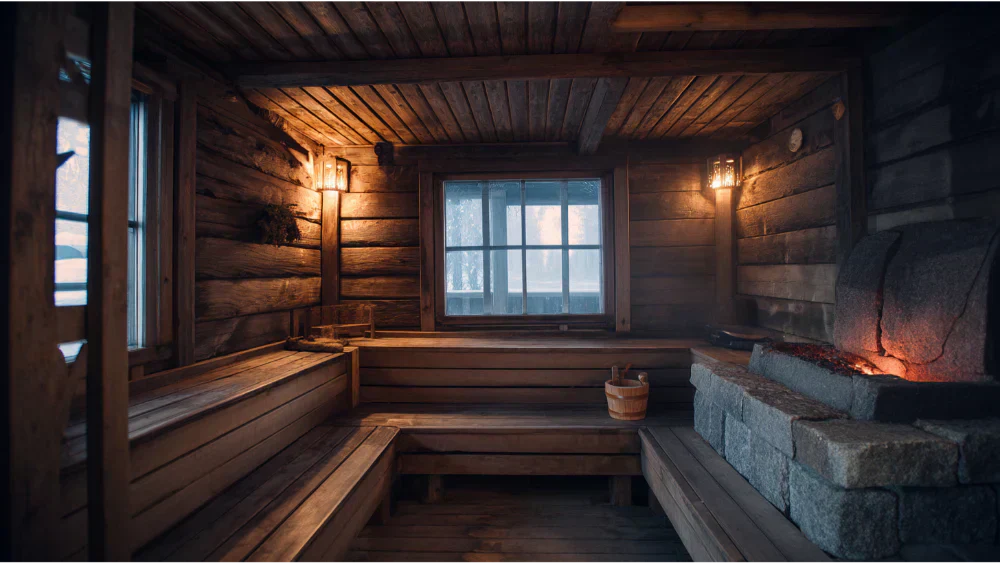Why sauna temperature matters
Step into a Kyfe Sauna and feel the first shift, as air temperature rises, blood flow increases, and your mind begins to unwind. The sauna temperature you choose affects the quality of your sauna session and your sauna experience, from heat exposure and humidity level to steam and relaxation. Understanding the importance of sauna temperature and humidity levels ensures you get the best sauna temperature for your needs.
Choosing a hot sauna that is too intense can overwhelm beginners, while lower air temperatures may feel like merely standing in a warm room rather than enjoying traditional saunas with therapeutic benefits. The recommended temperature for sauna depends on your personal preference, health goals, and type of sauna, whether wood burning saunas, electric saunas, or infrared saunas.
How Hot Should a Sauna Be For Tradition and Health

Traditional Finnish saunas and temperature range
Traditional Finnish sauna lovers follow guidelines from Finnish sauna society for maintaining integrity of tradition and health benefits. The traditional Finnish sauna or Finnish sauna ritual usually involves a temperature range of 150 to 195°F, often around 170 to 190°F for serious sauna lovers seeking hotter temperatures and real steam. In a wood burning sauna or a steam sauna, that temperature and humidity level brings forward real löyly, steam that enhances relaxation and mimics authentic Finnish tanning traditions.
Ideal temperature vs best sauna temperature
Finding the ideal sauna temperature for you means balancing traditional standards and your own comfort. Best sauna temperature recommendations often fall between 158 and 190°F, while researchers suggest health benefits may begin at 158°F and extend to around 212°F in clinical studies. However temperature and humidity matter far more than raw heat alone. Lower temperatures may be sufficient for beginners, while extended periods in higher temperatures often work for experienced users.
Infrared saunas vs traditional saunas
Infrared saunas heat your body directly using infrared light rather than raising air temperature. Infrared saunas heat typically max out at 120 to 160°F, which feels gentler than hot saunas. Infrared heat proponents praise deep tissue warmth and convenience, but these saunas lack real steam rooms or wood burning and therefore may not offer the same ritual or cardiovascular health perks as a traditional sauna. Temperature range in infrared saunas is thus often lower than ideal sauna temperature standards for therapeutic benefits.
Comparing different types of saunas and their benefits
Wood burning saunas and electric saunas
Wood burning saunas are classic Finnish sauna options with real fire and hot stones, producing real steam when water is poured on sauna rocks. Temperature range for these saunas is often 150 to 195°F, while electric saunas that use sauna heater elements can reach similar temperatures but lack the ritual of fire tending. Electric saunas still offer dry heat and temperature control, but they usually produce deeper humidity only when water is poured on hot stones over a sauna heater.
Infrared saunas heat vs dry sauna
Infrared saunas use infrared lamps to heat the body directly, offering a different experience than a dry sauna or wood burning sauna. The air temperature remains lower, usually in the 120 to 160°F range. That means less heat exposure in the air but deep infrared heat penetration in muscles. Choose the type of sauna that meets your personal preference and desired temperature targets, whether that means dry heat, infrared heat, or wet sauna steam experiences.
How to choose the best sauna temperature
Understanding temperature and humidity levels
Air temperature alone does not determine your experience. Humidity level plays a big role. A dry sauna with 150°F and low humidity feels quite different from a wet sauna or steam sauna with the same temperature but high humidity. When you pour water on sauna rocks in a traditional Finnish sauna, temperature and humidity shift rapidly, producing rolling steam and a unique sensation. How hot a sauna feels often depends on both temperature and humidity levels, so balancing these is key.
Determining your desired temperature
Your preferred temperature will reflect both your comfort and what you hope to achieve. For beginners, a lower temperature range of 150 to 165°F may feel warm and relaxing. For sauna lovers seeking hotter temperatures and greater therapeutic benefits, around 170 to 190°F or even higher may be ideal. Always increase heat gradually, listening to your body and ensuring temperature does not spike too quickly.
Exact temperature vs temperature range
While some resources cite an exact temperature, like 174°F, the ideal protocol is using a temperature range—150 to 195°F works well, with most users finding best sauna temperature between 170 and 185°F. If your sauna can hold between 158 and 212°F, be cautious. Some users may tolerate higher temperatures for short periods, but extended periods above 200°F are reserved for experienced sauna users and should be done safely with medical clearance.
Health benefits of the right sauna temperature

Cardiovascular health and blood flow
Using a sauna at the right heat triggers vasodilation, which improves blood vessels and boosts blood flow. Research shows sauna use at around 158 to 190°F may reduce blood pressure and promote improved cardiovascular health. This blood flow boost is among the most cited therapeutic benefits of sauna use.
Core body temperature and cardiovascular benefits
During a quality sauna session, your core body temperature will increase slightly, prompting heart rate to rise and circulation to strengthen. This mimics low to moderate exercise, delivering cardiovascular health benefits and improved oxygen delivery. That makes getting the best temperature crucial for sustaining benefits without risking overheating.
Mental relaxation and stress relief
Proper heat exposure in a sauna session supports mental relaxation, endorphin release and reduced cortisol. A session at 170°F with steam from hot stones enhances the feeling of calm more than infrared heat use in a lower-temperature sauna. The combination of herbal aromas, real löyly, and camaraderie in a traditional Finnish sauna environment provides deeper soothing than steam rooms or dry air alone.
How to regulate sauna heat and humidity
Measuring air temperature and humidity
For humidity, a hygrometer can show your humidity level, or you can simply observe steam intensity. Pouring water on sauna rocks creates bursts of steam, increasing humidity and making the air feel hotter. Adjust your vent to regulate airflow, which helps refine the temperature range.
Using sauna heater and vents effectively
In wood burning saunas, open intake vent for more oxygen, producing a stronger fire and higher temperature. Control vent position gradually to hit your temperature target. Electric saunas have built-in sauna heaters with settings. Irregularly turning the sauna heater on and off can create large fluctuations, so err on the side of slow adjustment.
Avoiding common mistakes in heat regulation
Do not overload with logs at once, which can produce spikes in heat and excess noxious smoke. Avoid pouring too much water on sauna rocks, which can cause scalding steam. Always start at moderate temperature and increase slowly over your sauna session. That ensures comfort, safety and consistent benefits.
Sauna session planning: timing and temperature guidelines
Duration recommendations based on sauna temperature
Match your sauna session length to the heat. In a session around 150 to 165°F, 15 to 20 minutes may be comfortable. When the temperature climbs to the best sauna temperature range around 170 to 190°F, reduce to 10 to 15 minutes. When pushing higher temperatures briefly, such as above 195°F, shorten sessions to 5 to 10 minutes.
Structure of a multi-round sauna session
Many traditional saunas follow a multi-round ritual with heat, cool down, and repeat. A sample sauna session might start with a 10-minute round, followed by a cold shower or a cold plunge. Rest briefly, then re-enter for another 8 to 12 minutes. Repeat two or three times depending on your tolerance and desired heat exposure.
Hydration and cooling strategies to support cardiovascular health
Always stay hydrated, sipping water before, during, and after your session. Consider a cold shower or cold plunge to tightly close blood vessels, improving circulation and recovery. Cold shower after sauna also boosts alertness and enhances therapeutic benefits.
Safety considerations for hotter temperatures

Pre existing medical issues and medical clearance
Higher temperatures may not suit people with heart conditions, pregnancy, low blood pressure, or other pre existing medical issues. Consult your doctor before using extreme heat. Even healthy adults should start with moderate temperature and increase gradually as they learn to tolerate higher temperatures.
Core body temperature monitoring and tolerance
High heat temporarily raises core body temperature. Symptoms like dizziness, headache, nausea, or fatigue signal it is time to exit. Extended periods in excessive heat can heat related illness, so it is better to stay in your comfort zone. Listen to your body's signals and never push past what you can tolerate.
When to limit hotter sauna temperatures
People who cannot tolerate higher temperatures should stick to lower temperatures in a dry sauna or a mild steam sauna. Consider infrared saunas heat instead, which can offer therapeutic benefits with less stress on core body temperature. Stay cautious with higher temperatures if you are on medication, have a blood pressure problem, or are dehydrated.
Enhancing your sauna experience
Creating atmosphere with steam rooms and hot stones
Using sauna rocks to produce steam bursts transforms a hot sauna into a steam sauna. At times temperature may decrease briefly when steam disperses, but it enhances the experience. Use essential oils diluted in water to brighten aromas and enrich steam aroma.
Pairing sauna use with cold shower and cold plunge
Alternating sauna sessions with cold shower or a cold plunge is a classic wellness practice. That contrast of hot and cold sharpens circulation, calms the nervous system, and magnifies relaxation and cardiovascular recovery.
Personal preference and temperature adjustments
Some sauna lovers enjoy lower temperatures and longer sessions around 150 to 165°F, while others aim for hotter temperatures and shorter, more intense sessions at 180°F or higher. Your sauna experience should reflect balance and enjoyment. Customize the session length, temperature, humidity level, and steam control to meet your wellness goals.
Frequently Asked How Hot Should a Sauna Be Questions
What is the best sauna temperature for general relaxation?
Most users find 150 to 175°F ideal for a relaxing sauna session that still provides health benefits. That range offers a pleasant dry heat or mild steam environment.
How hot should traditional saunas be?
Traditional Finnish or wood burning saunas typically operate between 150 and 195°F. The exact temperature depends on preference and heat tolerance.
Are infrared saunas effective at lower temperatures?
Infrared saunas operate at lower air temperature, usually 120 to 160°F. They are effective for muscle recovery and gentle heat exposure, but they lack the real steam rooms and intense heat that provide cardiovascular benefits.
Can a steam sauna be too hot?
Yes. Steam sauna temperatures above 195°F with high humidity can be overwhelming. Stick to 150 to 175°F for a comfortable steam sauna, and use shorter sessions if you prefer hotter temperatures.
Is a hot sauna safe for blood pressure?
Using a sauna at the best sauna temperature—around 170°F—can improve blood pressure and blood flow. However individuals with existing blood pressure issues should consult a doctor and monitor blood pressure carefully.
How often should I use the sauna for cardiovascular benefits?
3 to 4 sessions per week, each around 10 to 15 minutes at 170°F or hotter, have been linked to improved cardiovascular health. Frequency and consistency matter more than extreme temperatures.
Conclusion
When deciding how hot should a sauna be, the answer is not one exact temperature but a desirable range, typically 150 to 195°F for traditional saunas and steam rooms, or 120 to 160°F for infrared saunas. The ideal sauna temperature depends on your personal preference, health goals, and how you want to balance dryness, steam, and heat.
The best sauna temperature for many users is around 170 to 185°F, offering therapeutic benefits, increased blood flow, relaxation, and mental reset without causing undue stress. Choose your temperature thoughtfully, time your sauna sessions wisely, stay hydrated, and incorporate cool-down practices like cold shower or cold plunge to support cardiovascular health.
Kyfe’s wood burning saunas offer ample control over temperature, humidity, and steam through sauna heater settings, vents, and quality sauna rocks. Whether you prefer a lower temperature session for calm, or hotter temperatures for deeper therapeutic effect, Kyfe’s versatile designs help you achieve consistent, quality sauna experience wherever you go.
Ready to experience the transformative power of tradition, fire, steam, and intentional warmth? Unlock your best sauna session with Kyfe today.



Is Sauna Good for Skin? The Definitive Guide to Skin Health Through Sauna Bathing
How to Use a Sauna: The Ultimate Wellness Ritual